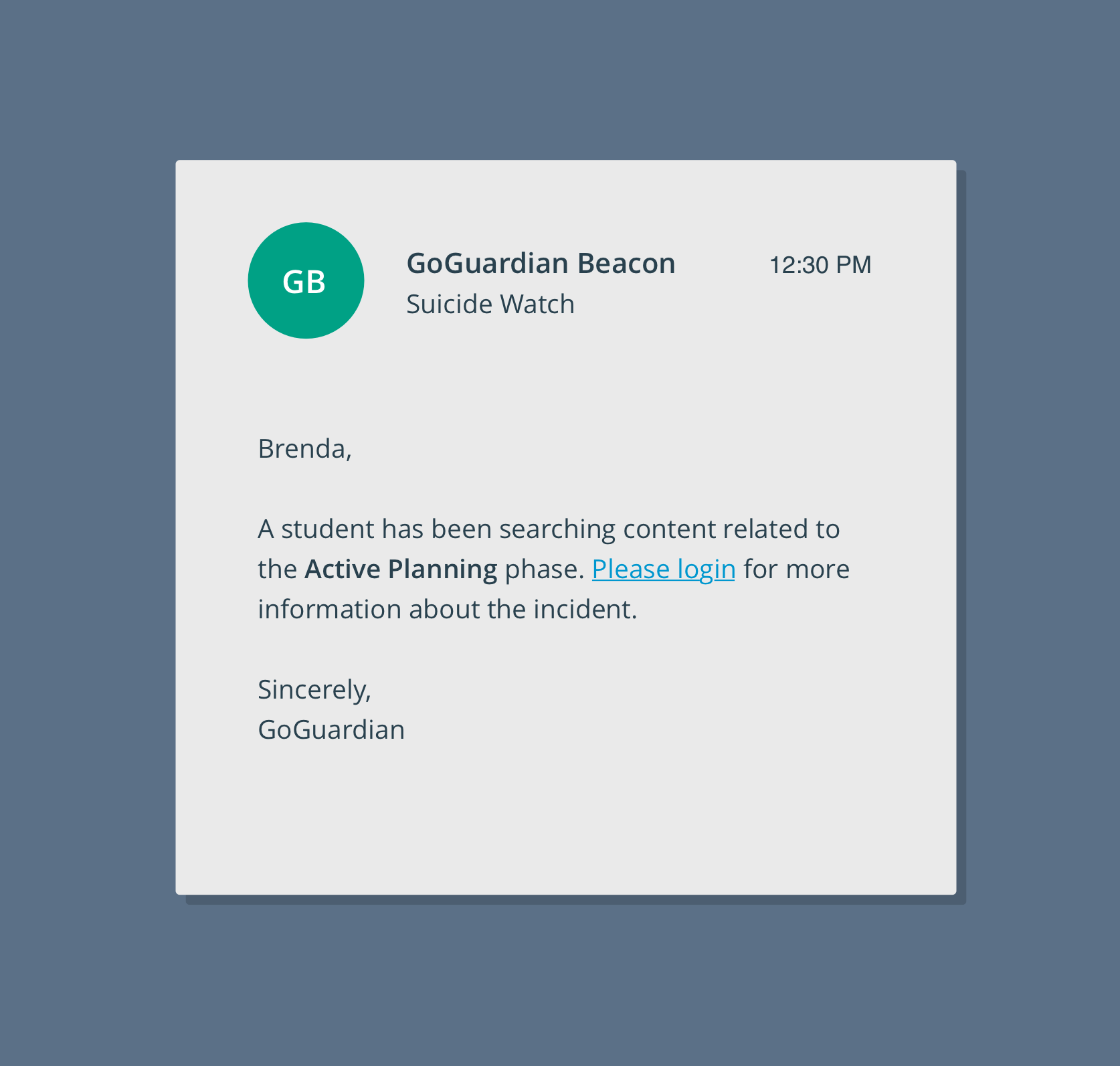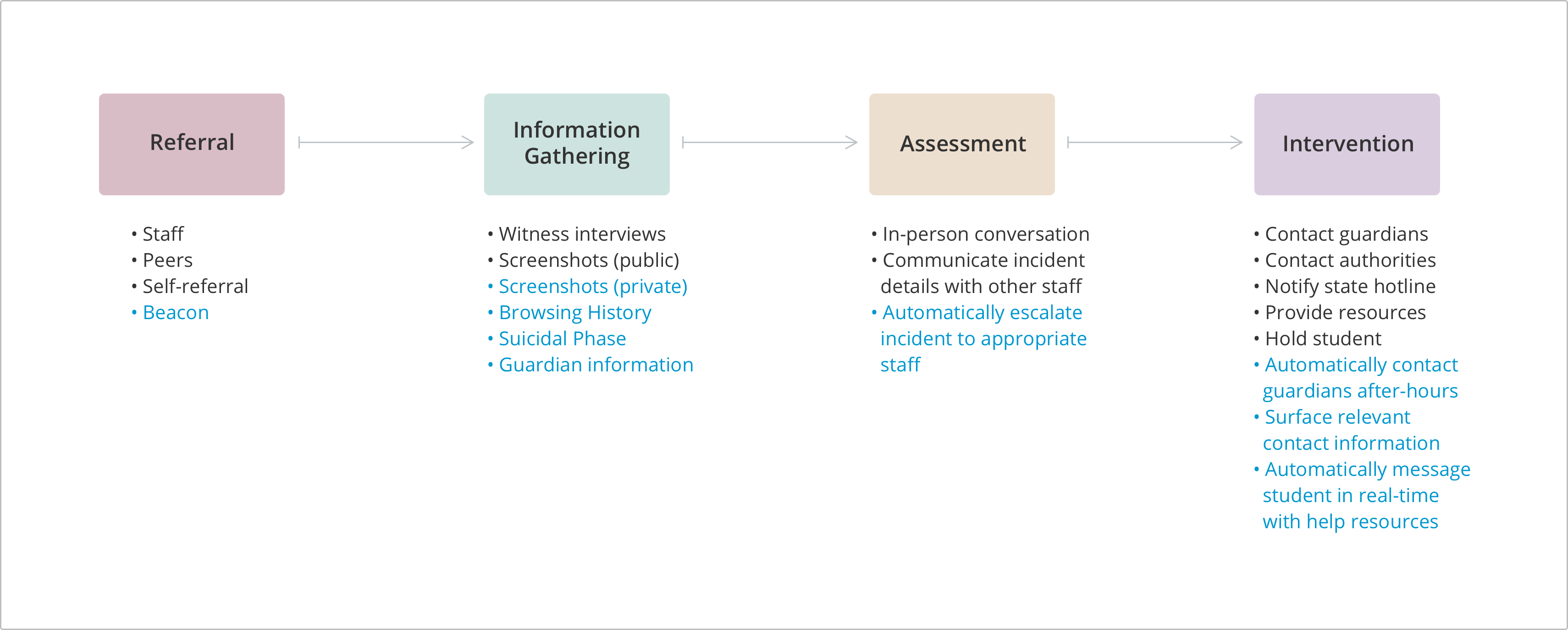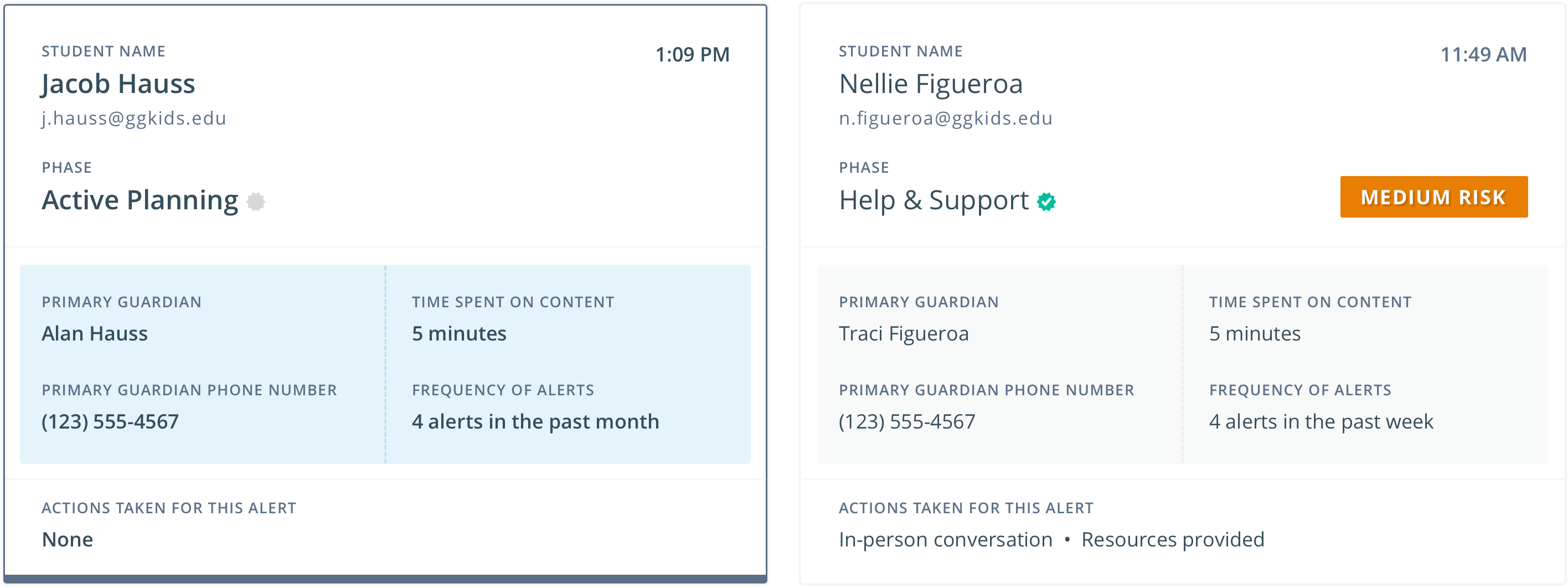GoGuardian is an educational technology company based in El Segundo, California. Our Admin and Fleet products allow school IT administrators to monitor and filter browsing activity on school-issued Chromebooks (and now Windows devices) and manage devices. Our Teacher product allows teachers to monitor student screens during class sessions and lock down devices or limit browsing for focused learning.
Realizing that we were uniquely positioned to leverage machine learning models to help detect the risk of suicidal ideation in students we sought out to figure out how to address that problem.
However, our existing users -IT administrators and teachers– were not equipped to handle this kind of information. We set out to find the best human for the job within schools' existing personnel. This meant we needed to understand a completely new user base, serve them well and also consider how our existing user bases would be affected. This project was affectionately known as Project Tiger.
As part of GoGuardian's product process, new market/user opportunities are assessed with only a product manager and a designer.
As part of GoGuardian's product process, new market/user opportunities are assessed with only a product manager and a designer.

I pitched renaming Project Tiger to 'Beacon,' shining a light on what had previously remained in the dark and a symbol of hope. Storytelling while designing is a part of my process and I needed to be able to ground the story of this product with a name deserving of its purpose.
Target user: School Counselors or Mental Health Professionals in schools
With the assistance of the American Association of Suicidology, the American Foundation for Suicide Prevention, and the American School Counselors Association we were able to speak to 35+ school counselors and school psychologists to understand their existing processes. From those conversations we were able to distill and validate a basic process that applied to all respondents.
EXISTING PROCESS


1. Increased referral volume with additional source. Possibly resource restricting.
1. Impossible to reduce volume of referrals coming from Beacon without missing urgent incidents. Additional staff would help but not something we can help with.
1. Focus on making the rest of their process faster to mitigate increased referral volume and/or lack of resources.
2. Notifying as many people as possible while minimizing redundancies.
2. Allow schools to customize who gets notified and when by creating a digital calling tree for escalations. Must be able to apply as a general solution for the entire school.
2. Schools can set an Escalation List with single or multiple users per tier. Schools then designate an interval time in which the first tier users have to respond to an alert before it is escalated to tier 2 (and so on depending on their number of tiers). Escalation continues on an infinite loop until a user notes an action has been taken for this referral, i.e. Parents were contacted.
3. Keeping track of staff activity per incident.
3. Track user actions and control who can interact with the referral.
3. Users can mark a task or "action" as complete on a per-referral basis. Any actions marked as done are saved in an imutable table per referral.
Permission levels (Director, Counselor, Viewer) allow schools to customize who can interact with a referral. Allowing other stakeholders, like principals and superintendents, to review as needed.
4. Making notifications actionable while prioritizing student privacy.
4. Users can prioritize and designate urgency based on our model's prediction about what phase of suicidal ideation the student was just browsing. Provide phase name and easy log in link.
4. No personally identifying information is included in email or text message notifications, however our model can bucket each referral into one of five suicidal or self-harm categories (Active Planning, General Suicide Ideation, Generic Suicide Research, Help & Support, and Self-Harm), which is included in each email or text message notification allowing users to prioritize accordingly.
5. Psychological and emotional toll is higher when having to deal with referrals on user's personal time. i.e. Week nights and weekends.
5. Provide other resources and engage reliable relationships available to the student after-hours.
5. Schools have an option to turn on automatic Parent/Legal Guardian notifications for after-hours referral. Schools also have the option to send a message to the student in real time providing them with helpful resources.
Deliverables
As part of GoGuardian's product process requirements, the product manager and designer must present a completed prototype of the experience in order to get approval for build. The prototype must be found viable, technically feasible, and usable by leaders from every department in the company.
My final delivery list included: product name, beacon/lighthouse illustration for marketing, product page design (now deprecated), complete product prototype for engineering team, multiple prototypes for sales team enablement, technical design documentation, and workflows.

• From our research, we discovered users who were ill-equipped to handle these types of alerts because there was no existing school policy in place. We partnered with the American Foundation for Suicide Prevention to create a model policy for schools to use or build off of. AFSP also provides free on-site school staff training for all GoGuardian customers.
• We've since expanded the categories of content we can report on for a more comprehensive view of a school's mental health concerns.
• From our research, we discovered users who were ill-equipped to handle these types of alerts because there was no existing school policy in place. We partnered with the American Foundation for Suicide Prevention to create a model policy for schools to use or build off of. AFSP also provides free on-site school staff training for all GoGuardian customers.